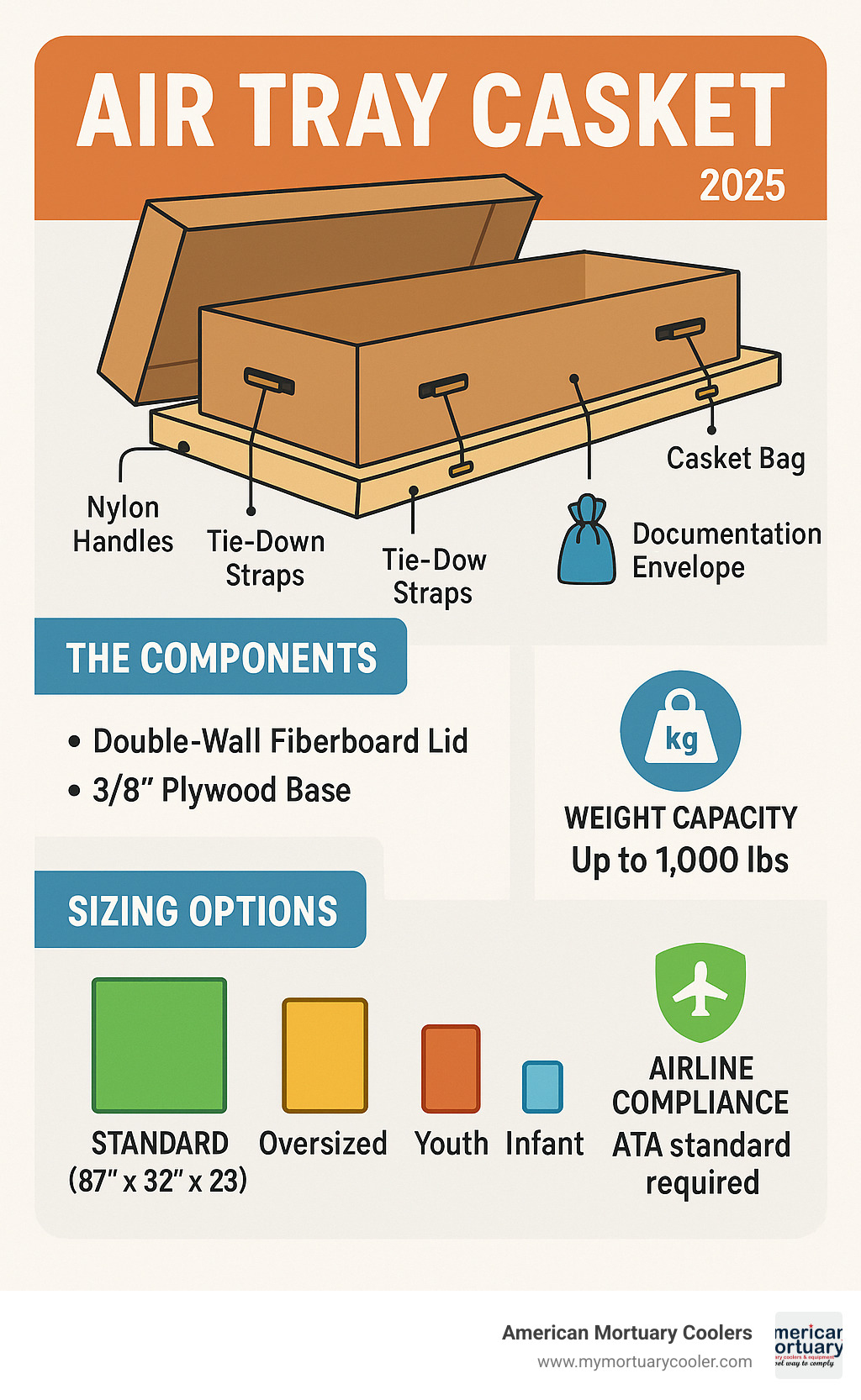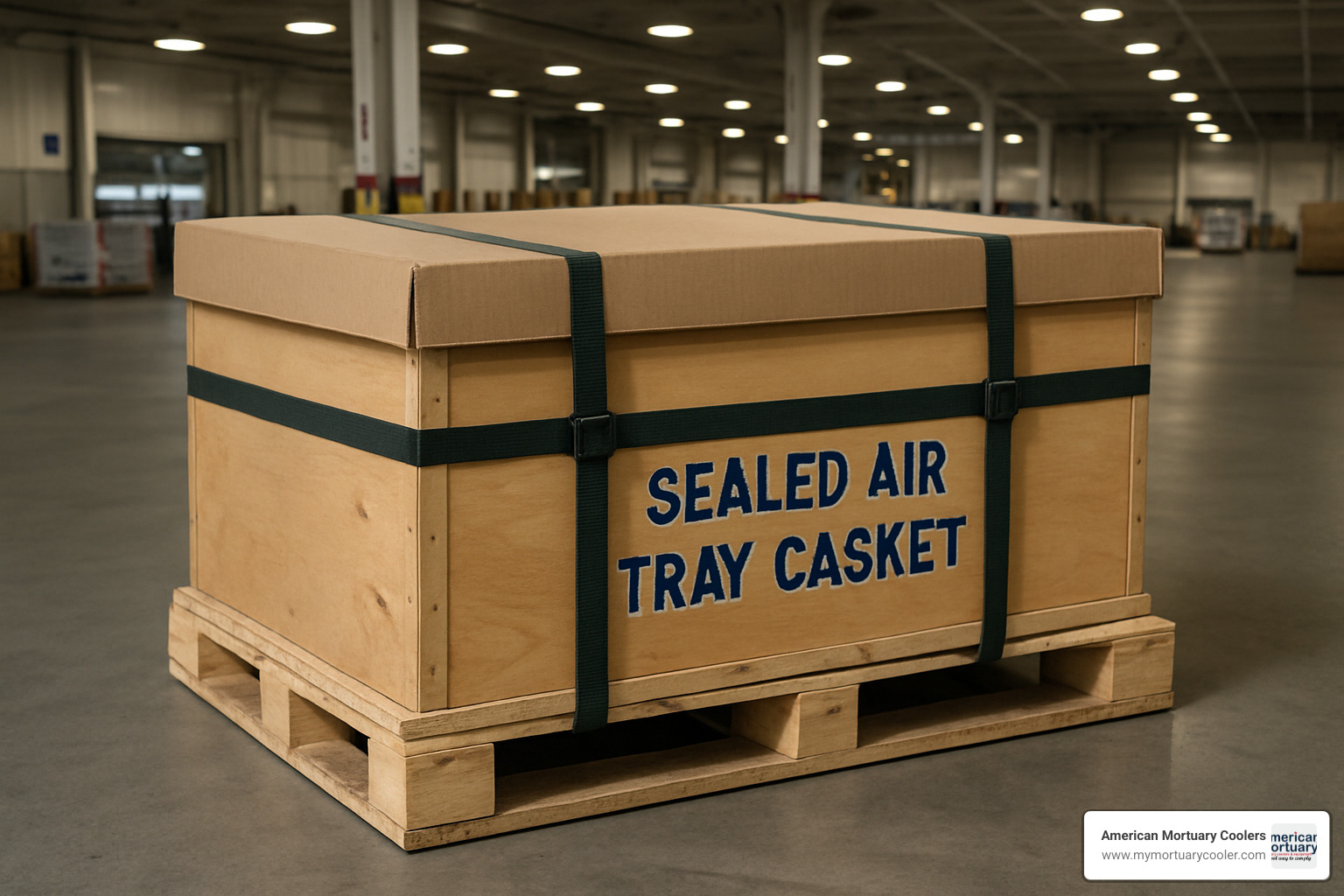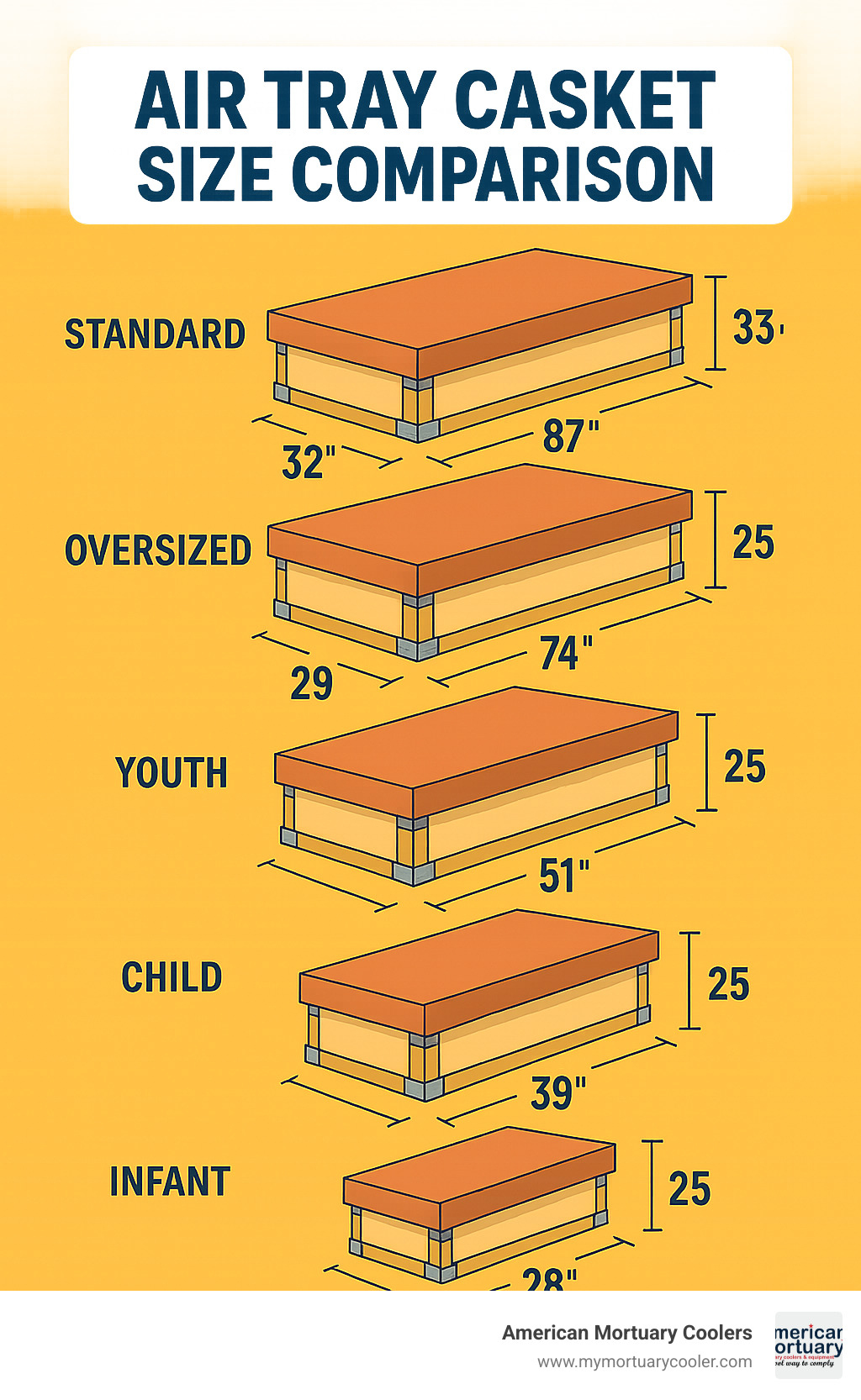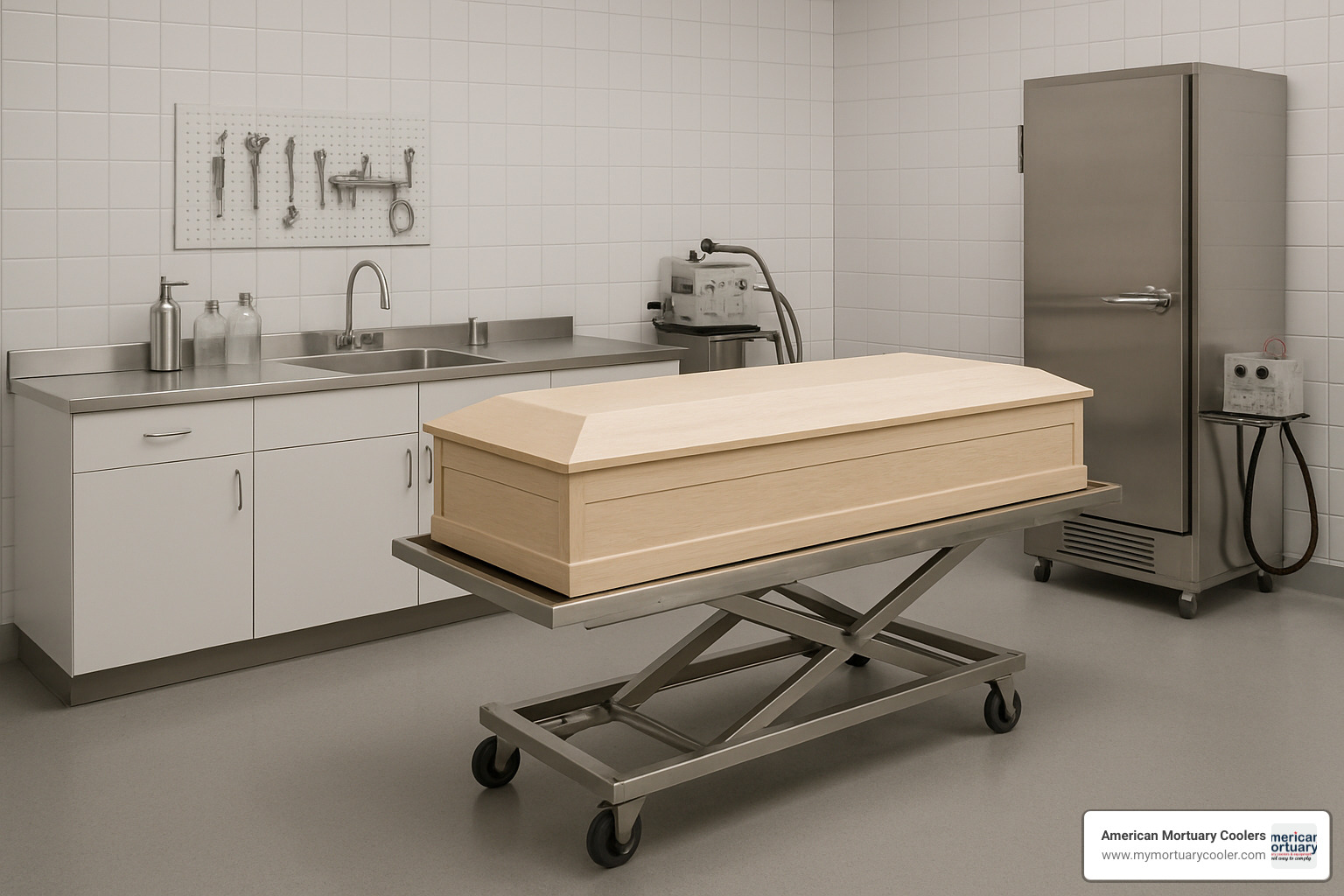
An Essential Guide to Air Tray Casket Options
Why Air Tray Caskets Are Essential for Funeral Directors
An air tray casket is a specialized shipping container designed to safely transport casketed human remains by air, meeting strict airline regulations for domestic and international shipping.
Key Features:
- Construction: 3/8" plywood base with double-wall corrugated fiberboard lid
- Capacity: Third-party tested to support up to 1,000 lbs
- Certifications: Heat-treated and bug-stamped for international compliance
- Components: Includes nylon handles, tie-down straps, casket bag, and documentation envelope
- Sizes: Available in standard (87"×32"×23"), oversized, youth, child, and infant dimensions
Air tray caskets are required by airlines for shipping casketed remains because they provide leak-proof protection and meet Air Transport Association (ATA) standards. Without proper certification, your shipment will be rejected at the cargo facility.
As American Mortuary Coolers, we've helped funeral directors steer the complexities of mortuary equipment for over a decade, including sourcing compliant air tray casket solutions that meet both budget constraints and regulatory requirements.

Quick air tray casket definitions:
What Is an Air Tray Casket & Why It Matters

Without an air tray casket, airlines will reject your casket shipment. These specialized shipping containers aren't just recommended - they're absolutely required by airlines for transporting human remains.
Think of an air tray casket as a protective cocoon that wraps around your regular casket. It creates a sealed, leak-proof barrier that meets strict airline safety standards. The wooden base and reinforced walls can handle rough cargo treatment, while interior padding keeps everything secure during flights.
Airlines classify human remains as hazardous materials, requiring special handling. The air tray casket addresses every safety concern airlines have about biological risks and structural integrity.
For funeral directors expanding services, understanding these containers is crucial. Learn more about selecting the right funeral equipment to support your growing business needs.
Primary Purpose of an Air Tray Casket
The air tray casket has one job: get your casket safely from point A to point B by air. These containers undergo rigorous third-party testing to ensure they can handle up to 1,000 pounds of weight - more than enough for even the heaviest caskets and remains.
The secure transport design addresses every challenge of air cargo. Reinforced corners prevent damage when cargo handlers stack containers. Double-wall construction creates multiple barriers against potential leaks. Those nylon handles give cargo crews safe grip points for loading and unloading.
A standard air tray casket weighs only 50-58 pounds, leaving plenty of room within airline cargo limits. This careful engineering means you can ship standard caskets without worrying about exceeding weight restrictions.
How Air Trays Differ from Other Containers
Combo trays are designed for uncasketed remains, including foam mattresses and body straps. They're lighter weight with less structural support for casket transport.
Transfer cases are the heavy-duty option with thick steel and hermetic seals, weighing over 200 pounds empty. They're perfect for ground transport where maximum protection matters more than weight limits.
The air tray casket hits the sweet spot - strong enough for airline handling, light enough for cargo weight limits, and certified for all regulatory requirements.
Anatomy of an Air Tray Casket: Materials, Components, Assembly
When you examine an air tray casket, you'll find impressive engineering. These containers aren't just thrown together - every component serves a specific purpose in keeping your shipment safe during cargo transport.
The foundation starts with a 3/8" plywood base built to handle serious weight without flexing. The double-wall corrugated lid creates a protective shell that's lightweight yet durable.
Reinforced corners take impact when cargo handlers are loading. Nylon straps with heavy-duty buckles keep everything locked down tight. That casket bag inside provides backup protection against moisture issues.
The packing slip envelope securely attaches documentation - having papers properly attached saves major headaches at customs or cargo facilities.
| Component | Air Tray Casket | Combo Tray |
|---|---|---|
| Base Material | 3/8" Plywood | Corrugated Cardboard |
| Weight Capacity | 1,000 lbs | 350-400 lbs |
| Intended Use | Casketed Remains | Uncasketed Remains |
| Handles | 6-8 Nylon | 4-6 Cardboard |
| Certification | IATA/ATA Compliant | Limited |
How to Assemble an Air Tray Casket
Putting together an air tray casket isn't complicated, but doing it right matters. Start with lid placement on a clean, flat surface. The wooden base should sit level with no wobbling. Once your casket is centered, slip that protective casket bag over everything.
The strap threading comes next. Those three tie-down straps need to go through designated slots and pull tight with double-locking buckles. Give each strap a firm tug - better to find problems now than at 30,000 feet.
Test each handle by lifting gently. They should feel solid and secure. Finally, place that absorbent pad inside the casket bag for extra protection.
Included Kit Components
Every quality air tray casket kit includes everything needed for successful shipment. The lid and base are the main components, supported by 6-8 handles strategically placed for balanced lifting.
You'll find 3 tie-down straps using heavy-duty materials that won't snap under pressure. That clear documentation pouch keeps paperwork with the shipment through multiple transfers.
The beauty of these kits is that nothing gets forgotten. When dealing with time-sensitive shipments and grieving families, having everything in one complete package removes stress from an already challenging situation.
Sizing, Weight Capacities & Available Options
Getting the right size air tray casket is crucial. There are five standard sizes to choose from, covering everything from infant caskets to oversized adult units.
The standard adult air tray casket measures 87"×32"×23" - your most common size for typical funeral home needs. Oversized units go up to 92"×36"×25" for bigger caskets needing extra room.
For smaller cases, youth models are 74"×29", child sizes are 51"×25", and infant options measure 39"×25". Each size maintains that crucial 1,000-lb weight capacity.
They use knock-down construction that reduces shipping height to just 4" when disassembled, allowing efficient storage without taking over your prep room.

For specific sizing options, you can select your tray from available sizes based on your exact casket dimensions.
Choosing the Right Air Tray Casket Size
Measuring for an air tray casket requires understanding inside versus outside dimensions and giving yourself adequate clearance.
Start with your casket measurements and add breathing space. For length, you'll want 3-4 inches of clearance beyond your casket length. Width needs 2-3 inches extra on each side.
Standard air tray caskets have inside dimensions of 83.75"×22.75", while the outside measures 87"×32"×23". That difference accounts for wall thickness and reinforced corners.
Don't squeeze an oversized casket into a standard tray - this compromises structural integrity and airlines will reject the shipment. Oversized units accommodate up to 90"×34" internally.
Casket handles often need extra width clearance, especially ornate ones extending beyond the casket body.
Special Use Cases
Medical schools regularly use these containers for transporting donated bodies for educational purposes. Repatriation services rely on the heat-treated wood and bug-stamp certification for overseas shipping.
Disaster response situations create urgent needs for rapid transport of remains. Law enforcement agencies sometimes need these containers for forensic investigations requiring specialized examination at distant facilities.
Each application relies on the same strengths - reliable protection, regulatory compliance, and professional handling.
Compliance, Certifications & Best Practices for Shipping
Shipping human remains by air requires understanding strict regulations. When dealing with an air tray casket, IATA standards govern every detail, and missing requirements can ground your shipment.
The wood must be ISPM-15 heat-treated - an international standard preventing invasive insects from crossing borders. Look for the bug stamp marking on the wood. Without this stamp, customs officials will reject your shipment.
ATA certification makes airlines willing to accept your shipment. For domestic transport, TSA rules add another layer of requirements.
Every shipment needs proper documentation. Death certificates, embalming certificates, transit permits - they all must be perfect. For complete technical details, the technical spec PDF covers all compliance requirements.
Step-by-Step: Safe Air Tray Casket Shipping
Start with permits. You'll need certified death certificate copies with official seals. Embalming certificates prove proper preparation. Transit permits from origin and destination states are both required.
Assembly inspection comes next. Check every component before packing. Look for cracks in the plywood base, damaged corners, or worn strapping. Ensure proper casket fit with adequate clearance.
Documentation accuracy can make or break shipments. Airline forms have zero tolerance for errors. Attach packing slip envelopes securely and double-check recipient information.
Chain-of-custody documentation protects everyone involved. Document transfers with signed receipts and provide tracking information to families.
Common Pitfalls to Avoid
Improper sizing happens frequently. If you're forcing the casket in, you're asking for trouble. Measure twice, order once.
Missing bug stamps kill international shipments. Customs officials won't accept wood without proper heat treatment certification.
Unsecured strapping creates safety hazards. Those double-locking buckles need to be snug but not over-tightened.
Incomplete documentation stops shipments cold. Create a master checklist and use it every time.
Cost, Purchasing Eligibility & Market Overview
When budgeting for an air tray casket, expect to invest between $150-$450 for most standard units. The price range reflects variety in sizes and certifications. Basic domestic shipping trays might cost $150, while oversized international-certified units could reach $450.
Wood pricing fluctuations affect costs, though manufacturers try maintaining stable pricing. Size upgrades typically add $50-100, with oversized units commanding highest premiums.
International certification costs more due to heat treatment and additional documentation. Bug stamp certification adds $25-50 per unit but is essential for overseas shipping.
Freight costs add another $50-150 depending on location and delivery speed. Rush orders can double these charges.
The air tray casket market has purchasing restrictions. Only qualified businesses can buy these containers - funeral homes, crematories, cemeteries, and medical schools. Private individuals cannot purchase them due to regulatory requirements.
For comprehensive supplier information, check our guide to funeral equipment suppliers.
Factors Influencing Price
Material thickness plays the biggest pricing role. Heavier plywood bases with reinforced corners cost more but provide better protection.
Certifications add cost but are non-negotiable. Heat treatment and bug stamping adds $25-50 per unit.
Rush lead-times hit budgets hard. Standard delivery runs 5-10 business days, but expedited shipping can double costs.
Volume discounts reward bulk orders. Most suppliers offer 10-15% discounts for multiple units.
Geographic location affects freight significantly. West Coast funeral homes typically pay more than Midwest locations.
Where to Source Air Tray Caskets
Regional distributors offer the best experience for most funeral homes. They maintain local inventory, provide technical support, and understand your market.
Direct manufacturers appeal to cost-conscious buyers ordering larger quantities. You'll save money but face longer lead times and higher minimums.
Airline cargo facilities sometimes stock units for last-minute needs, but expect limited selection and higher prices.
At American Mortuary Coolers, we connect funeral directors with reliable suppliers who understand both quality requirements and budget constraints.
Frequently Asked Questions about Air Tray Casket Shipping
Do airlines always require an air tray casket?
The short answer is yes - airlines universally require air tray caskets or equivalent certified containers for shipping casketed remains. This isn't a suggestion or recommendation; it's a hard requirement mandated by federal aviation regulations and individual airline policies.
Every major carrier from Delta to United to international airlines requires these containers because they meet strict ATA certification standards and provide the necessary documentation trail. Without proper certification displayed on the container, your shipment will be rejected at the cargo facility - no exceptions.
While some airlines might theoretically accept alternative containers, they must provide equivalent protection and carry the same certifications. In our experience working with funeral homes across Tennessee and beyond, the standardized air tray casket remains the most widely accepted solution across all carriers. It's simply not worth the risk of trying alternatives when families are counting on you.
What's the difference between an air tray casket and a combination tray?
Think of it this way: an air tray casket is built like a shipping crate for heavy cargo, while a combination tray is more like a protective bed for direct body transport.
The air tray casket features a sturdy wooden base designed specifically for casketed remains. It provides structural support for heavy caskets and includes reinforced corners that can handle the weight and stress of cargo handling. These units support up to 1,000 lbs - enough for even the heaviest caskets.
Combination trays, on the other hand, are designed for uncasketed remains. They include foam mattresses, body straps, and different interior configurations that accommodate direct body placement. Their weight capacity typically maxes out at 350-400 lbs - adequate for remains but nowhere near sufficient for a full casket.
Using the wrong type isn't just ineffective; it can be dangerous. We've seen cases where funeral homes tried to use combo trays for caskets, resulting in structural failure during transport. The weight difference alone makes this a critical distinction.
Can families buy an air tray casket directly?
Unfortunately, no - air tray caskets are restricted to professional buyers only. This includes funeral homes, crematories, cemeteries, and medical schools, but not individual families or the general public.
This restriction exists for good reason. Proper use of these containers requires specialized knowledge of regulations, assembly procedures, and documentation requirements. There's a lot that can go wrong - from improper assembly that compromises safety to missing documentation that stops shipments at customs.
Families needing shipping services should work directly with their funeral director, who can source the appropriate air tray casket and handle all the regulatory compliance issues. At American Mortuary Coolers, we work exclusively with funeral professionals who understand these requirements and can ensure everything is done correctly.
Your funeral director has the expertise to steer airline regulations, international shipping requirements, and proper assembly procedures - taking that burden off families during an already difficult time.
Conclusion

When families face bringing a loved one home from far away, the air tray casket becomes their silent guardian. It's more than just a shipping container - it's the bridge connecting grief to healing, distance to closure.
We've explored how these containers work, from the sturdy 3/8" plywood base supporting up to 1,000 pounds to the double-wall corrugated lid protecting against transport rigors. The five standard sizes, from infant containers at 39"×25" to oversized units measuring 92"×36"×25", ensure every family's needs can be met.
Technical details matter - IATA certification, heat-treated wood with bug stamps, and proper documentation - because they make the impossible possible. Without these certifications, shipments simply won't fly.
At American Mortuary Coolers, we've spent years helping funeral directors steer these complex logistics. The $150-450 investment in a quality air tray casket isn't just about compliance - it's about delivering peace of mind when families need it most.
Whether handling international repatriation, domestic transfers, or specialized transport, these containers provide the foundation for professional service. Success often comes down to choosing the right equipment and following proper procedures.
When you invest in proper air tray caskets and understand correct usage, you're investing in your ability to serve families during their most vulnerable moments.
For more insights into building a complete mortuary operation, check out The Complete Guide to Funeral Home Equipment to see how the right equipment choices can lift your entire service offering.



